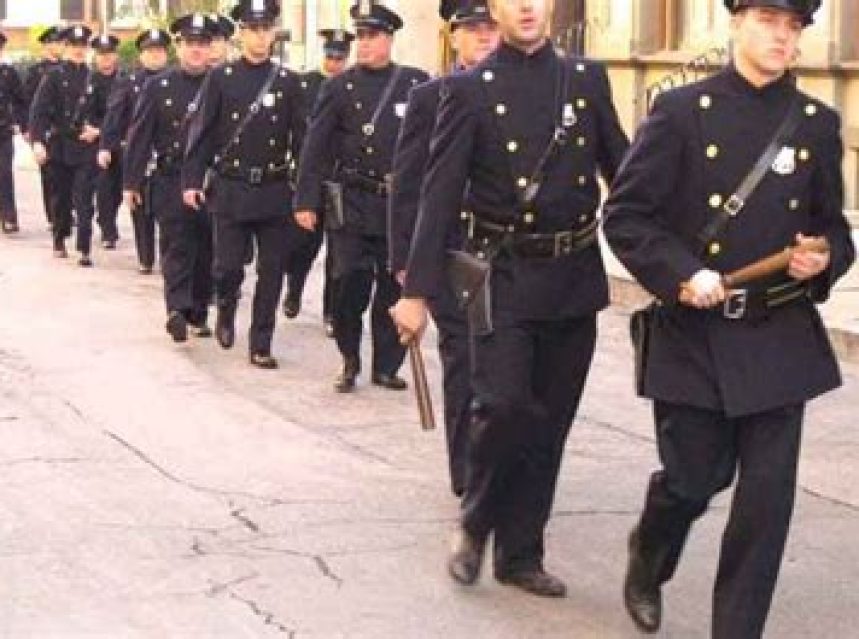1920 Police Uniform

The 1920s marked a significant era in the evolution of police uniforms, as law enforcement departments across the world underwent transformative changes in design and functionality. This blog post explores the influence of war on police uniform design and delves into the distinctive features that defined the 1920s police uniforms. It also sheds light on the various materials and colors that were utilized during this time. Additionally, we will examine the impact of these uniforms on modern designs, showcasing how the 1920s continue to leave a lasting impression on the world of law enforcement fashion.
Evolution of Police Uniforms in the 1920s
The evolution of police uniforms in the 1920s marked a significant shift in the way law enforcement officers presented themselves to the public. During this decade, police uniforms underwent substantial changes in terms of design, materials, and colors, reflecting the changing social and cultural landscape of the time. These transformations were influenced by various factors, such as advancements in technology, the aftermath of World War I, and the emergence of organized crime.
One of the distinctive features of 1920s police uniforms was the adoption of a more standardized and professional appearance. Prior to this decade, police officers wore a variety of different uniforms, often reflecting regional or departmental preferences. However, in the 1920s, efforts were made to establish a more uniform image of law enforcement across the country. This involved the introduction of common elements, such as brass buttons, double-breasted jackets, and a peaked cap, which became ubiquitous in police uniform design.
The materials used in 1920s police uniforms also underwent significant changes. With the advent of new synthetic fabrics and improved production techniques, law enforcement agencies began to incorporate more durable and functional materials into their uniforms. These included wool, cotton, and rayon, which offered enhanced comfort, breathability, and resistance to wear and tear. The use of heavy-duty fabrics in the construction of uniforms was seen as a practical measure to ensure that officers could perform their duties effectively in various weather conditions.
- Brass buttons
- Double-breasted jackets
- Peaked cap
- Wool
- Cotton
- Rayon
| Distinctive Features | Materials | Colors |
|---|---|---|
| Brass buttons | Wool | Dark blue |
| Double-breasted jackets | Cotton | Black |
| Peaked cap | Rayon | Khaki |
The colors chosen for 1920s police uniforms were also carefully selected to convey a sense of authority and professionalism. Dark blue, black, and khaki were the dominant colors used during this era, reflecting a transition from the more flamboyant and brightly colored uniforms of the previous centuries. The shift towards darker hues was seen as a way to project a more serious and authoritative image, mirroring the changing perception of police officers as guardians of law and order.
The evolution of police uniforms in the 1920s had a lasting impact on modern uniform designs. The introduction of standardized elements, such as the double-breasted jacket and peaked cap, established a template that continues to be recognized and emulated today. The focus on durability and functionality in the selection of materials set a precedent for the incorporation of modern fabrics and technologies in contemporary law enforcement attire. Furthermore, the choice of dark, authoritative colors served as a foundation for the psychological impact that uniforms can have on both officers and the public.
Influence of War on Police Uniform Design
When it comes to the design of police uniforms, many factors can influence their appearance. One significant factor that had a significant impact on police uniform design is war. Throughout history, wars have played a crucial role in shaping the way police uniforms are designed and worn. The influence of war on police uniform design can be seen prominently in the 1920s, a decade that witnessed significant global conflicts and social changes.
The aftermath of World War I significantly influenced the design of police uniforms in the 1920s. The war had brought about significant changes in society, and law enforcement agencies had to adapt to the evolving circumstances. Police uniforms during this period often featured elements borrowed from military uniforms. This borrowing of design elements from military attire was a result of the war’s impact, as police forces sought to establish a sense of authority and power in post-war society.
One distinctive feature of 1920s police uniforms influenced by war was the incorporation of epaulettes. Epaulettes, originally used in military uniforms, were adopted by police forces to convey a sense of rank and authority. These shoulder decorations not only added a touch of formality to the uniforms but also symbolized the militaristic influence on law enforcement during this time.
In addition to borrowing design elements, war also influenced the materials and colors used in 1920s police uniforms. As war demands increased, resources became scarce, leading to the adoption of more durable and economical fabrics for police uniforms. Uniforms began to be made from materials like wool, cotton, and rayon. The color palette also underwent changes, with darker shades like navy blue and black becoming more prevalent. These changes were a direct reflection of the effect that war had on the availability of resources and the need for practicality in uniform design.
- The aftermath of World War I significantly impacted police uniform design
- Police uniforms borrowed design elements from military attire
- Epaulettes were a distinctive feature influenced by war
- Materials like wool and rayon were used due to resource scarcity
- Darker shades like navy blue became more prevalent
| Key Points |
|---|
| The aftermath of World War I significantly impacted police uniform design |
| Police uniforms borrowed design elements from military attire |
| Epaulettes were a distinctive feature influenced by war |
| Materials like wool and rayon were used due to resource scarcity |
| Darker shades like navy blue became more prevalent |
Distinctive Features of 1920s Police Uniforms
The 1920s marked a significant period in the evolution of police uniforms. During this time, law enforcement agencies sought to create a more recognizable and authoritative image for their officers. This led to the introduction of several distinctive features that became synonymous with 1920s police uniforms.
One of the notable features of 1920s police uniforms was the integration of **brass buttons**. These buttons were not only functional but also added a touch of elegance to the overall appearance. The buttons were often embossed with the department’s emblem or insignia, further emphasizing the officer’s identity and authority.
Another prominent feature of 1920s police uniforms was the **wide-brimmed hat**, commonly known as the **’bobby hat’**. This hat not only provided protection from the elements but also served as a distinguishable symbol of authority. It became synonymous with policing during this era and is still recognized today as an iconic element of vintage police uniforms.
The **double-breasted jacket** was also a distinctive feature of 1920s police uniforms. This style became popular during the era, symbolizing professionalism and a sense of formality. The jacket was often tailored to emphasize the officer’s physique and was complemented by a **matching trousers** to complete the ensemble.
Additionally, **an overcoat or trench coat** was commonly worn by police officers in the 1920s, especially during inclement weather. These coats were usually knee-length, providing both warmth and protection. The overcoats often featured a belt or waistline, which not only added a stylish touch but also emphasized the officer’s authority.
| Distinctive Features of 1920s Police Uniforms |
|---|
| Brass Buttons |
| Wide-Brimmed Hat |
| Double-Breasted Jacket |
| Matching Trousers |
| Overcoat or Trench Coat |
In conclusion, the distinctive features of 1920s police uniforms played a significant role in shaping the image and identity of law enforcement officers during that era. The use of brass buttons, wide-brimmed hats, double-breasted jackets, matching trousers, and overcoats contributed to a more recognizable and authoritative presence. These features not only reflected the fashion trends of the time but also emphasized the professionalism and authority of the police force. Even today, elements of 1920s police uniforms continue to influence modern uniform designs, ensuring a sense of tradition and heritage within law enforcement agencies.
Materials and Colors Used in 1920s Police Uniforms
The 1920s marked a significant period in the evolution of police uniforms. During this time, materials and colors used in the design of these uniforms underwent notable changes. The materials chosen for police uniforms during this era were carefully selected to ensure durability, functionality, and a sense of authority. Additionally, the colors of the uniforms played a crucial role in distinguishing and identifying police officers in their line of duty.
In terms of materials, wool was widely used for 1920s police uniforms. Wool was chosen for its ability to provide warmth and durability, making it ideal for officers who had to brave harsh weather conditions. The fabric was often blended with other materials such as cotton or linen to enhance breathability and comfort on a day-to-day basis.
Another commonly used material for 1920s police uniforms was leather. Leather was primarily used for accessories such as belts, gloves, and boots. Its durability and rugged appearance added to the overall authoritative and professional look of the uniform. Leather belts were not only functional but also served as symbolic representations of authority.
When it comes to colors, police uniforms in the 1920s typically featured a combination of dark and neutral tones. Dark blue was a popular choice for uniforms, as it was believed to convey a sense of authority and professionalism. Navy blue, in particular, became synonymous with police uniforms during this era. Other colors such as black, gray, and brown were also used, providing a practical and understated look for officers.
In conclusion, the materials and colors used in 1920s police uniforms were carefully chosen to serve specific purposes. Wool and leather were prominent materials, ensuring durability, functionality, and a professional appearance. Dark and neutral colors such as dark blue, black, gray, and brown were selected to convey authority and professionalism. These factors played a significant role in shaping the overall design of police uniforms during this era and continue to influence modern designs today.
Impact of 1920s Police Uniforms on Modern Designs
The impact of 1920s police uniforms on modern designs can be seen in various aspects of contemporary law enforcement attire. These iconic uniforms from the Roaring Twenties not only reflected the fashion trends of the era but also introduced several distinctive features that have influenced police uniform design to this day.
One notable impact is the introduction of tailored uniforms for both male and female officers. In the 1920s, police uniforms began to shift away from the traditional military-style attire towards more fitted and fashionable garments. The use of tailored jackets and trousers not only enhanced the overall appearance of law enforcement personnel but also provided practicality and comfort during duty.
Another significant influence of 1920s police uniforms on modern designs is the incorporation of distinctive features such as chevrons, shoulder straps, and brass buttons. These elements, which were commonly found in the uniforms of the time, added a sense of authority and professionalism to police officers. Today, many police departments still utilize these features to signify ranks and distinguish officers from other individuals.
- Tailored uniforms: The 1920s saw a shift towards more fitted and fashionable police attire, which continues to influence modern designs.
- Distinctive features: Chevrons, shoulder straps, and brass buttons were commonly used in 1920s police uniforms, and their incorporation in modern designs adds authority and professionalism to law enforcement personnel.
The materials and colors used in 1920s police uniforms also left a lasting impact on contemporary designs. During this period, wool and cotton were commonly used for uniform construction, providing durability and comfort. The predominant color scheme consisted of navy blue or black, which remains a popular choice in modern police uniforms due to its association with authority and tradition.
| Materials Used | Colors Used |
|---|---|
| Wool | Navy blue |
| Cotton | Black |
In conclusion, the impact of 1920s police uniforms on modern designs is evident in the tailored nature of contemporary law enforcement attire, the incorporation of distinctive features, and the choice of materials and colors. These influences not only uphold the professionalism and authority associated with police uniforms but also pay homage to the rich history and iconic fashion trends of the Roaring Twenties.
Frequently Asked Questions
Q1: How did the design of police uniforms evolve in the 1920s?
In the 1920s, police uniforms underwent a significant transformation. They transitioned from the traditional long coats worn in the late 1800s to shorter, more practical tunics and trousers. This change was influenced by the need for greater mobility and functionality.
Q2: How did the war influence the design of police uniforms?
The First World War had a notable impact on police uniform design. It introduced more utilitarian features such as epaulettes, cargo pockets, and belts, which were inspired by military uniforms. These additions aimed to enhance functionality and provide police officers with the tools they needed to perform their duties effectively during wartime.
Q3: What distinctive features characterized 1920s police uniforms?
1920s police uniforms were characterized by several distinctive features. These included high-collared tunics with brass buttons, Sam Browne belts, wide-brimmed hats, and long leather boots. These elements combined to create a recognizable and authoritative appearance for police officers during this period.
Q4: Which materials were commonly used in 1920s police uniforms?
During the 1920s, police uniforms were typically made from high-quality wool or serge fabrics. These materials were chosen for their durability, breathability, and the professional image they conveyed. Leather was also commonly used for boots, belts, and other accessories to provide durability and a polished appearance.
Q5: What were the primary colors used in 1920s police uniforms?
The primary colors used in 1920s police uniforms were navy blue, black, and sometimes dark brown. These colors were chosen for their ability to hide dirt and maintain a professional and authoritative presence. Additionally, brass buttons and accessories were often used for ornamental purposes and to add a touch of refinement.
Q6: How did 1920s police uniforms influence modern designs?
The 1920s police uniforms had a lasting impact on modern designs. Many elements from this era, such as the tunic style, Sam Browne belts, and wide-brimmed hats, continue to be incorporated into contemporary police uniforms. These designs reflect the legacy and tradition associated with law enforcement.
Q7: Are any current police uniform designs directly inspired by the 1920s?
While modern police uniform designs have evolved over time, some elements can be traced back to the 1920s. For instance, the use of brass buttons, high-collared tunics, and distinctive headwear can still be seen in certain police forces today, showcasing the influence and enduring legacy of the 1920s police uniform.



